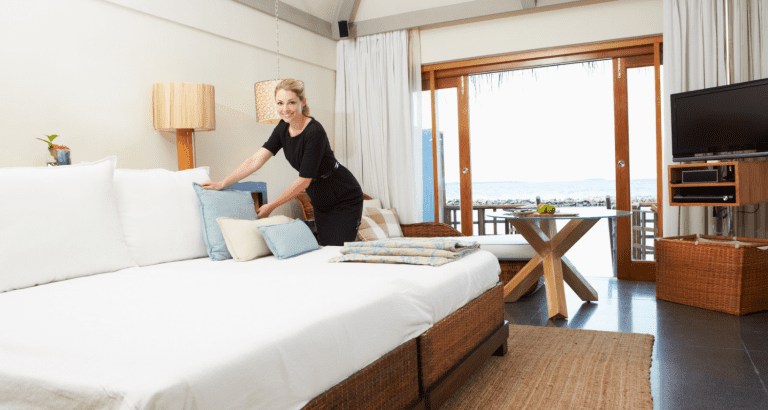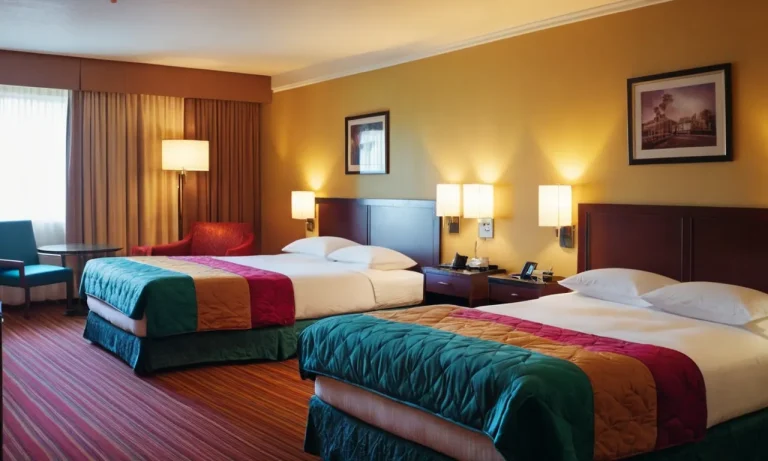How to Use HDMI on Hotel TV: A Comprehensive Guide
Are you tired of being confined to the limited entertainment options provided by hotel TVs? Worry no more! Connecting your personal devices to the hotel TV via HDMI can unlock a world of possibilities, allowing you to stream your favorite shows, movies, and even play games during your stay.
If you’re short on time, here’s a quick answer to your question: To use HDMI on a hotel TV, locate the HDMI input ports on the TV, connect one end of an HDMI cable to your device (laptop, gaming console, streaming device, etc. ), and the other end to the TV’s HDMI input. Then, switch the TV’s input source to the corresponding HDMI port using the remote control or the TV’s menu.
In this comprehensive guide, we’ll dive deep into the process of using HDMI on hotel TVs, covering everything from identifying compatible devices and cables to troubleshooting common issues. Whether you’re a tech-savvy traveler or someone seeking a more enjoyable hotel experience, this article will equip you with the knowledge and tips you need to make the most of your hotel TV.
Understanding HDMI and Its Advantages
When traveling and staying in hotels, having the ability to connect your personal devices to the TV can greatly enhance your entertainment experience. This is where HDMI (High-Definition Multimedia Interface) comes into play.
HDMI is a digital interface that transmits high-quality audio and video signals from one device to another, such as from your laptop or gaming console to the hotel TV.
What is HDMI?
HDMI is a compact audio/video interface that transmits uncompressed digital data. It was developed to simplify the connection of audio/video components, providing a single cable solution for transmitting both audio and video signals.
HDMI supports high-definition video resolutions, including 4K and 8K, as well as various audio formats, including Dolby Digital and DTS. According to the HDMI organization, HDMI has become the standard for connecting HDTVs, Blu-ray players, game consoles, and other high-definition devices.
Benefits of Using HDMI on Hotel TVs
- Superior Picture and Sound Quality: HDMI provides a crystal-clear picture and immersive audio experience, ensuring you enjoy your favorite movies, TV shows, or games in the best possible quality.
- Plug-and-Play Convenience: With HDMI, you can easily connect your devices to the hotel TV without the hassle of multiple cables or complex setups. Just plug in the HDMI cable, and you’re good to go!
- Wide Compatibility: HDMI is widely adopted and supported by a vast range of devices, from laptops and smartphones to gaming consoles and streaming devices.
- Future-Proof Technology: As HDMI continues to evolve, it supports higher resolutions, faster data transfer rates, and advanced features like HDR (High Dynamic Range) and eARC (Enhanced Audio Return Channel).

Compatibility with Various Devices
One of the great advantages of HDMI is its compatibility with a wide range of devices. Here are some common devices that you can connect to a hotel TV using HDMI:
| Device | Description |
|---|---|
| Laptops | Connect your laptop to the hotel TV to enjoy movies, presentations, or work on a larger screen. |
| Smartphones and Tablets | With the right adapter or cable, you can mirror your smartphone or tablet’s screen onto the hotel TV for a bigger viewing experience. |
| Gaming Consoles | Bring your gaming console on your trip and connect it to the hotel TV for an immersive gaming experience. |
| Streaming Devices | Devices like Roku, Amazon Fire TV Stick, or Chromecast can be connected to the hotel TV via HDMI, giving you access to your favorite streaming services. |
With HDMI, you can enjoy a seamless and high-quality entertainment experience in your hotel room, whether you’re catching up on your favorite shows, working on a presentation, or indulging in some gaming fun. Don’t forget to check with the hotel staff about any specific requirements or restrictions regarding HDMI connectivity. 👍
Preparing for HDMI Connectivity
Traveling with your favorite entertainment devices has become a breeze, thanks to the widespread adoption of HDMI technology. However, connecting your gadgets to a hotel TV can sometimes be a daunting task, especially if you’re unfamiliar with the process.
Fear not, as this comprehensive guide will walk you through the essential steps to ensure a seamless HDMI connection during your stay.
Identifying HDMI Ports on Hotel TVs
The first step in establishing an HDMI connection is to locate the HDMI ports on the hotel TV. These ports are typically found on the back or side of the television, and they may be labeled as “HDMI,” “HDMI In,” or have a corresponding HDMI logo.
Keep in mind that some older TV models may not have HDMI ports, in which case you’ll need to explore alternative connection methods. Many hotel guests consider HDMI connectivity as an important feature in their hotel room TV. This highlights the growing demand for seamless entertainment experiences while traveling.
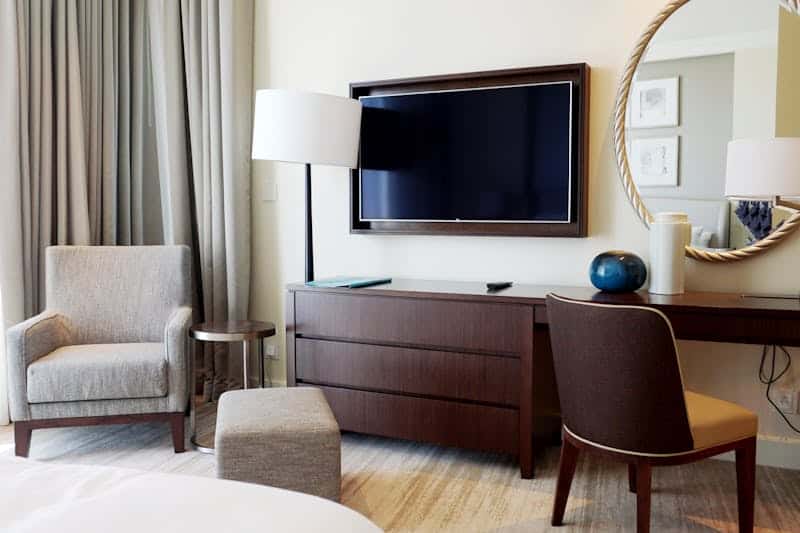
Choosing the Right HDMI Cable
Once you’ve identified the HDMI ports, the next step is to ensure you have the appropriate HDMI cable. HDMI cables come in various lengths and versions, each with its own capabilities and limitations. For instance, HDMI 2.1 cables support higher resolutions, frame rates, and enhanced features like eARC and VRR, making them ideal for modern gaming consoles and 4K/8K content.
- If you’re planning to connect a laptop or streaming device, a standard HDMI cable should suffice.
- For gaming consoles or high-end media players, consider investing in a high-speed HDMI cable that can handle the increased bandwidth requirements.
- Additionally, ensure that the cable length is appropriate for your setup, as longer cables may introduce signal degradation or compatibility issues.
Packing Essential Accessories
Beyond the HDMI cable, there are a few essential accessories you should consider packing for a hassle-free HDMI experience:
- A portable HDMI adapter or dongle, especially if you’re traveling with a tablet or smartphone. These adapters allow you to mirror your device’s screen onto the hotel TV.
- A travel-friendly power strip or USB hub, as hotel rooms often have limited power outlets. This will ensure you can charge all your devices simultaneously.
- A universal remote control app on your smartphone, which can help you navigate the hotel TV’s interface and control your connected devices seamlessly.
By following these simple steps and packing the right accessories, you’ll be well-prepared to enjoy your favorite movies, shows, or games on the hotel TV during your stay. Don’t let connectivity issues dampen your travel experience – embrace the power of HDMI and immerse yourself in entertainment bliss!
Step-by-Step Guide to Connecting HDMI
Connecting your personal device to a hotel TV can be a game-changer for entertainment during your stay. With the widespread use of HDMI (High-Definition Multimedia Interface) cables, this process has become more straightforward than ever.
In this section, we’ll guide you through the simple steps to connect your device to the hotel TV via HDMI, ensuring a seamless experience.
Connecting Your Device to the HDMI Cable
The first step is to locate the HDMI port on your device. Most modern devices, such as laptops, tablets, and gaming consoles, have at least one HDMI port. If you’re unsure, consult the device’s manual or do a quick online search.
Once you’ve identified the port, take your HDMI cable and firmly plug one end into your device’s HDMI port. According to Statista, over 5 billion HDMI-enabled products were shipped worldwide in 2021, highlighting the popularity and versatility of this interface.
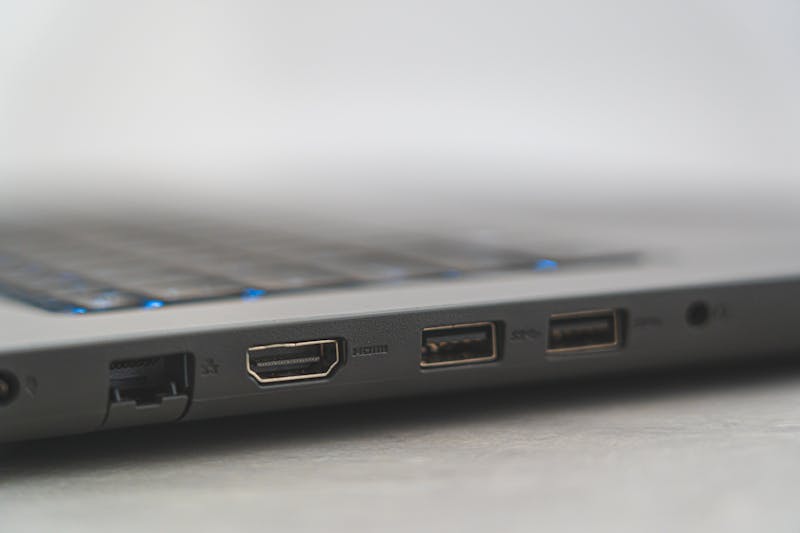
Connecting the HDMI Cable to the Hotel TV
With your device connected to the HDMI cable, it’s time to connect the other end to the hotel TV. Most modern TVs have multiple HDMI ports, typically located on the side or back panel.
Locate an available HDMI port and plug in the other end of the cable. Ensure that the connection is secure and tight. Don’t worry if you can’t find an HDMI port on the TV; many hotels provide HDMI cables or adapters upon request at the front desk. 😊
Switching the TV’s Input Source
After connecting your device and the HDMI cable to the TV, you’ll need to switch the TV’s input source to the appropriate HDMI port. This step is crucial, as it tells the TV to display the content from your connected device. To do this, grab the TV remote and look for an “Input” or “Source” button.
Press it, and a menu should appear with various input options, including HDMI ports. Use the remote’s navigation buttons to select the HDMI port you connected your device to.
If you’re having trouble finding the right input, don’t hesitate to ask the hotel staff for assistance – they’re usually happy to help!
And that’s it! You’ve successfully connected your device to the hotel TV via HDMI. Now you can enjoy your favorite movies, shows, games, or even mirror your device’s screen for a more immersive experience. Isn’t technology amazing? Just remember to disconnect everything before checking out, and you’re good to go!
Optimizing Your HDMI Experience
Adjusting TV Settings for Best Picture Quality
To ensure you get the best possible picture quality when using an HDMI connection on a hotel TV, it’s essential to adjust the TV settings appropriately. Many hotel TVs come with default settings that may not be optimized for the best viewing experience, so a few tweaks can make a significant difference.
Start by accessing the TV’s menu and navigating to the “Picture” or “Display” settings. From here, you can adjust the brightness, contrast, color, and sharpness levels to suit your preferences and the room’s lighting conditions.
It’s generally recommended to keep the brightness and contrast at moderate levels, while boosting the color and sharpness slightly for a more vibrant and detailed image.
Additionally, most modern TVs offer advanced picture modes like “Movie,” “Game,” or “Vivid,” designed to enhance specific types of content. Using the “Movie” or “Cinema” mode can often result in the most accurate and natural-looking colors, making it an ideal choice for watching films or shows.
On the other hand, the “Game” mode typically reduces input lag, which is crucial for gaming or using interactive apps. Don’t hesitate to experiment with these modes to find the one that suits your needs best.
Enabling Audio Output Through HDMI
While HDMI is primarily known for transmitting high-quality video, it can also carry audio signals, eliminating the need for separate audio cables. To take advantage of this feature, you’ll need to ensure that the TV’s audio output is set to HDMI.
This setting is typically found in the “Sound” or “Audio” menu of the TV’s settings. Once enabled, the TV will automatically route the audio from your HDMI source (like a laptop, gaming console, or streaming device) through the HDMI cable and to the TV’s speakers or any connected external audio system.
If you’re experiencing issues with audio output through HDMI, such as no sound or inconsistent volume levels, try checking the audio settings on both the TV and the connected device. Ensure that the volume is turned up on both ends and that the audio output on the source device is set to HDMI or “HDMI/AV” if available.
Additionally, some hotel TVs may have a “Hotel Mode” or “Hospitality Mode” that can interfere with audio output, so you may need to temporarily disable this mode to get the audio working properly.
Using Hotel TV Remote for HDMI Control
Most hotel TV remotes are designed to provide basic control over the TV’s functions, including switching between input sources like HDMI. To use an HDMI input on a hotel TV, start by locating the “Input” or “Source” button on the remote.
Pressing this button should bring up a menu or cycle through the available input options. Look for an option labeled “HDMI” or something similar, and select it to switch the TV to the desired HDMI input.
Some hotel TV remotes may also have dedicated buttons for specific HDMI inputs, such as “HDMI 1” or “HDMI 2,” allowing you to switch directly to that input without navigating through menus.
Additionally, many modern remotes include navigation buttons (up, down, left, right) and an “OK” or “Enter” button, which can be used to navigate the TV’s on-screen menus and adjust settings like picture mode or audio output.
If you’re having trouble using the hotel TV remote or can’t seem to find the right buttons, don’t hesitate to ask the hotel staff for assistance. They should be able to provide you with guidance on how to properly use the remote and access the HDMI inputs.
Remember, a little patience and exploration can go a long way in optimizing your HDMI experience on a hotel TV. 😊
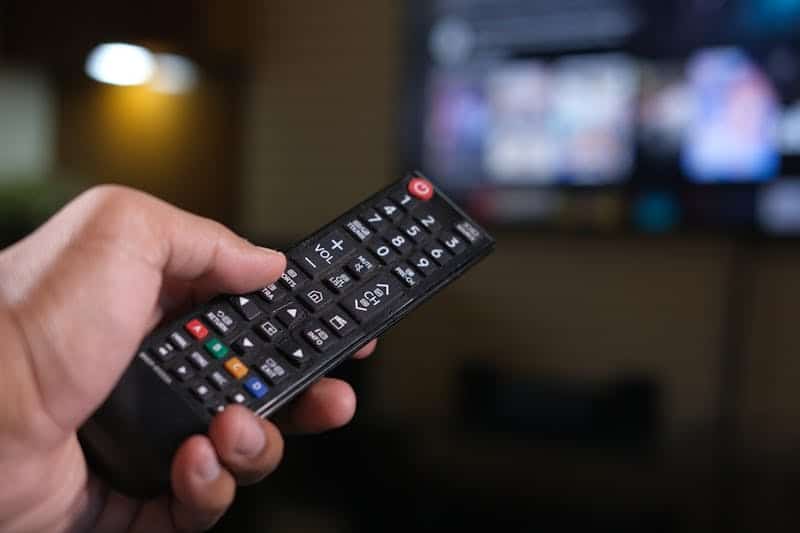
Troubleshooting Common HDMI Issues
Even with the convenience of HDMI connectivity, problems can sometimes arise when trying to connect your device to a hotel TV. Don’t worry, though – many of these issues are easily fixable with a few simple steps. Here are some common HDMI troubles you might encounter and how to troubleshoot them.
No Signal or Blank Screen
If you’re not getting any picture or signal on the TV after connecting your HDMI cable, there are a few potential culprits to investigate.
First, check that both ends of the HDMI cable are securely plugged in and that the input source on the TV is set correctly. According to Lifewire, some HDMI issues stem from loose or faulty cables, so try swapping out the cable if possible.
Another common cause of a blank screen is an incompatible resolution or refresh rate between your device and the TV. Many modern TVs support a wide range of resolutions, but older models may have more limited capabilities.
If you’re still having trouble, try changing the resolution or refresh rate on your device to see if that resolves the issue.
Audio Problems
While HDMI is designed to carry both video and audio signals, sometimes the audio can get disrupted or fail to work properly. If you’re experiencing no sound or intermittent audio dropouts, the first step is to check that the TV’s audio output is set to the HDMI input you’re using.
You may also want to try adjusting the audio settings on your device, such as enabling HDMI audio output or selecting the correct audio codec.
In some cases, the audio issue may be related to the HDMI cable itself. Older or lower-quality cables may not be able to handle the bandwidth required for high-definition audio formats like Dolby Digital or DTS.
If you suspect the cable is the culprit, try swapping it out for a newer, high-speed HDMI cable that supports the latest audio standards. 👍
Compatibility Issues with Older Devices
As technology advances, compatibility can become a challenge when connecting older devices to newer TVs or vice versa. If you’re having trouble getting your device to work with the hotel TV, it’s worth checking if there are any known compatibility issues between the two.
One potential solution is to look for firmware updates for your device or the TV itself, as these updates often include compatibility fixes and improvements. You can usually find firmware updates on the manufacturer’s website or through the device’s settings menu.
If compatibility remains an issue, you may need to consider using an adapter or converter to bridge the gap between your device and the TV. For example, an HDMI-to-VGA adapter can be useful for connecting older computers or laptops that don’t have an HDMI port.
Remember, don’t be afraid to ask the hotel staff for assistance if you’re really stumped – they may have experience dealing with similar issues or access to additional resources. With a little troubleshooting and patience, you should be able to get your HDMI connection up and running smoothly. 🎉
Conclusion
Utilizing HDMI on hotel TVs can significantly enhance your entertainment experience during your stay. By following the steps outlined in this guide, you’ll be able to seamlessly connect your devices, enjoy your favorite content, and make the most of your hotel room’s amenities.
Remember, preparation is key. Pack the necessary cables and accessories, familiarize yourself with the hotel TV’s HDMI ports, and don’t hesitate to seek assistance from the hotel staff if you encounter any issues.
With a little bit of knowledge and the right tools, you can transform your hotel room into a personalized entertainment hub.
So, the next time you find yourself in a hotel room, don’t settle for limited options. Embrace the power of HDMI and unlock a world of entertainment possibilities right at your fingertips. Happy streaming, gaming, and enjoying your favorite content on the go!

